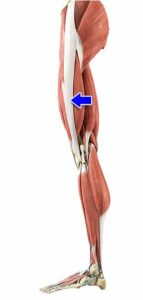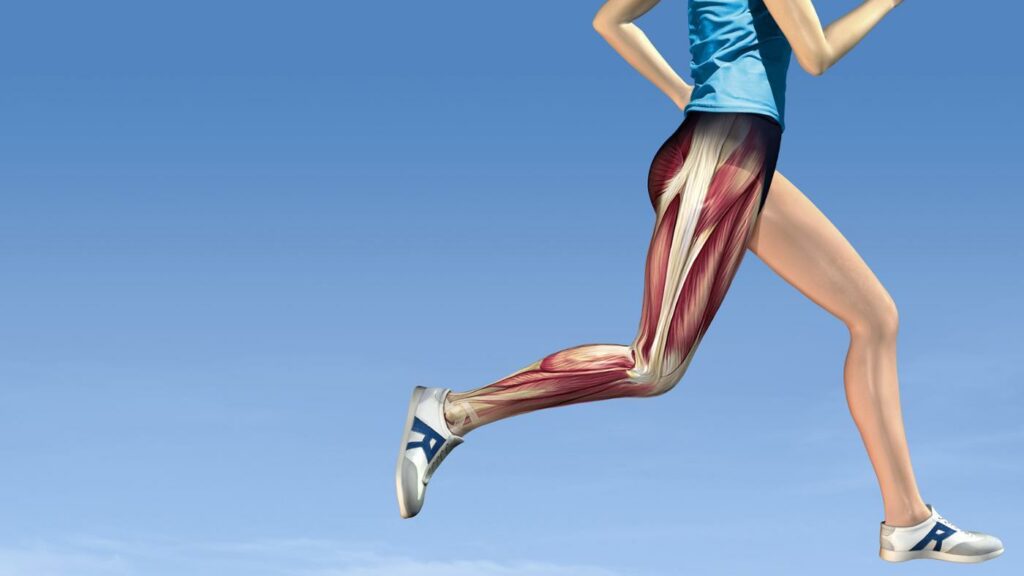Iliotibial Syndrome: Welcome to a comprehensive guide on iliottibial syndrome, often referred to as “IT band syndrome.” If you’re a runner or engage in regular physical activity, you may have encountered this frustrating and sometimes debilitating condition. In this article, we’ll delve into the causes, symptoms, diagnosis, treatment options, and prevention strategies for iliottibial syndrome, ensuring you’re well-equipped to conquer this common running ailment and get back to the activities you love.
Contents
Understanding the Anatomy of the Iliotibial Band

The iliotibial band (IT band) is a thick, fibrous band of connective tissue located on the outside of the thigh. It plays a crucial role in stabilizing the knee joint during movement and is involved in various lower limb functions, such as running and walking. Understanding its anatomy can provide insights into its importance and potential issues related to it.
Anatomy:
The IT band is a continuation of the tensor fasciae latae muscle’s (TFL) fascia, a muscle located on the lateral side of the hip. The TFL merges with the fibers of the gluteus maximus, a major hip extensor muscle. The IT band runs down the lateral side of the thigh, attaching to the lateral femoral epicondyle, which is a bony prominence on the outer side of the thigh bone (femur) just above the knee joint.
Causes and Risk Factors of Iliotibial Syndrome
Iliotibial Band Syndrome (ITBS) is a common overuse injury that affects the iliotibial band, causing pain and discomfort on the lateral side of the knee and thigh. Several factors can contribute to the development of ITBS. These include:
1. Overuse and Repetitive Activities: ITBS often occurs due to repetitive activities that involve bending and straightening the knee, such as running, cycling, hiking, and stair climbing. These activities can lead to increased friction between the iliotibial band and the lateral femoral epicondyle.
2. Poor Biomechanics: Abnormal biomechanics can result in improper alignment and movement patterns, leading to increased stress on the iliotibial band. Factors like excessive inward rotation of the hip, leg length discrepancy, and improper foot mechanics can contribute to ITBS.
3. Muscle Imbalances: Weakness or imbalance in the hip and thigh muscles, particularly the gluteus medius and gluteus maximus muscles, can alter hip stability and movement mechanics. This can lead to increased strain on the iliotibial band during activities.
4. Training Errors: Sudden increases in training intensity, duration, or frequency without proper conditioning and gradual progression can overload the iliotibial band and lead to irritation and inflammation.
5. Improper Footwear: Wearing shoes that don’t provide adequate support or don’t match the individual’s biomechanics can affect lower limb alignment and contribute to ITBS.
6. Running Surface: Running on uneven or slanted surfaces can cause the pelvis to tilt and alter the mechanics of the iliotibial band, increasing the risk of irritation.
Recognizing Symptoms of Iliotibial Syndrome
Iliotibial Band Syndrome (ITBS) is pain and discomfort on the lateral (outer) side of the knee and thigh. Recognizing the symptoms of ITBS is important for early diagnosis and appropriate management. The symptoms of ITBS can vary in intensity and presentation, but common signs include:
- Lateral Knee Pain: The most characteristic symptom of ITBS is pain on the outer side of the knee joint. The pain is often described as a sharp or burning sensation and is typically aggravated by activities that involve bending and straightening the knee, such as running, cycling, or walking downhill.
- Pain During Activity: Pain usually starts after a certain duration of activity, especially when the knee is repeatedly bent and straightened. Initially, the pain might be mild and gradually worsen with continued activity.
- Pain Intensity: The pain can range from mild discomfort to sharp and severe pain, making it difficult to continue the activity.
- Pain Location: The pain is typically localized near the lateral femoral epicondyle, which is the bony prominence on the outer side of the thigh bone (femur) just above the knee joint.
- Pain Radiation: In some cases, the pain might radiate up the lateral thigh or down the leg.
- Stiffness: Tightness or stiffness in the lateral thigh and hip region, particularly after activity, can be a common symptom.
- Pain Relief with Rest: The pain usually diminishes with rest, especially if the activity causing the pain is stopped.
- Snapping Sensation: Some individuals might experience a snapping sensation as the iliotibial band moves over the lateral femoral epicondyle, which can be uncomfortable or painful.
- Tenderness: Palpating the lateral femoral epicondyle might reveal tenderness or discomfort.

Diagnosing Iliotibial Band Syndrome (ITBS) involves a comprehensive medical assessment that includes a combination of clinical evaluation, patient history, and, in some cases, imaging studies. Here’s an overview of the diagnostic process:
1. Medical History: Your healthcare provider will start by asking you about your medical history, including any previous injuries, current symptoms, and activities that exacerbate or alleviate the pain. This information helps in understanding the context of your condition and its potential causes.
2. Physical Examination: During a physical examination, your healthcare provider will perform various tests to assess the alignment of your lower limbs, joint range of motion, muscle strength, and areas of tenderness. They might also observe your gait (walking pattern) and any specific movements that trigger your symptoms. Palpation of the lateral femoral epicondyle and surrounding tissues can help identify points of tenderness.
3. Functional Tests: Functional tests, such as Ober’s test, Noble’s compression test, and modified Thomas test, may be performed to assess the flexibility of the iliotibial band and identify any associated muscle imbalances.
4. Imaging Studies: In some cases, imaging studies like X-rays or MRI (Magnetic Resonance Imaging) may be recommended. X-rays can help rule out other conditions like structural abnormalities or arthritis, while an MRI can provide detailed images of soft tissues and help identify any inflammation, swelling, or changes in the iliotibial band itself.
5. Differential Diagnosis: Your healthcare provider will consider other potential causes of lateral knee pain and rule out conditions like lateral meniscus tears, bursitis, patellofemoral pain syndrome, and more. Differentiating between these conditions is crucial for accurate diagnosis and appropriate treatment.
Treatment Options for Iliotibial Syndrome
The treatment of Iliotibial Band Syndrome (ITBS) involves a combination of strategies aimed at reducing pain, addressing contributing factors, and promoting healing. Treatment options can vary based on the severity of the condition, individual factors, and the specific causes of ITBS. Here are some common approaches:
1. Rest and Activity Modification: Reducing or avoiding activities that exacerbate your symptoms is essential to allow the inflamed tissues to heal. This may involve temporarily stopping or decreasing high-impact activities like running or cycling.
2. Ice and Anti-Inflammatory Measures: Applying ice to the affected area can help reduce inflammation and alleviate pain. Non-prescription anti-inflammatory medications (NSAIDs) can help under the guidance of a healthcare provider.
3. Stretching: Gentle and targeted stretching of the iliotibial band, hip muscles, and surrounding structures can help improve flexibility and relieve tension. Common stretches include the iliotibial band stretch and hip flexor stretches.
4. Strengthening Exercises: Strengthening the muscles around the hip and thigh can improve biomechanics and reduce strain on the iliotibial band. Focus on exercises that target the gluteus medius and gluteus maximus muscles to improve hip stability.
5. Biomechanical Correction: Addressing any underlying biomechanical issues is crucial. This might involve working with a physical therapist to improve gait mechanics, footwear evaluation, and assessing leg length discrepancies.
6. Physical Therapy: A physical therapist can design a comprehensive rehabilitation program that includes stretching, strengthening, and functional exercises tailored to your specific needs. They can also guide you through proper exercise techniques and monitor your progress.
7. Corticosteroid Injections: In cases of severe pain and inflammation that don’t respond to conservative treatments, a corticosteroid injection might be considered. These injections can help reduce inflammation and provide temporary relief. However, they are typically used judiciously due to potential side effects.
Prevention Strategies

Preventing Iliotibial Band Syndrome (ITBS) involves addressing the underlying causes and implementing strategies to reduce the risk of irritation and inflammation of the iliotibial band. Here are some effective prevention strategies:
1. Gradual Progression: Avoid sudden increases in training intensity, duration, or frequency. Gradually progress your exercise routine to allow your body to adapt to the demands.
2. Proper Warm-Up: Engage in a dynamic warm-up before exercise to increase blood flow to muscles, improve joint mobility, and prepare your body for activity.
3. Strength Training: Incorporate strength training exercises for the hip, thigh, and core muscles. Focus on exercises that target the gluteus medius and gluteus maximus to improve hip stability.
4. Cross-Training: Include a variety of activities in your routine to prevent overuse injuries. Cross-training can help you maintain fitness while reducing the repetitive stress on the iliotibial band.
5. Biomechanical Assessment: Undergo a biomechanical assessment to identify any issues with gait, alignment, or muscle imbalances. Addressing these factors can help prevent excessive strain on the iliotibial band.
6. Proper Footwear: Choose appropriate footwear for your activity that provides adequate support and cushioning. Consider getting shoes that match your foot mechanics.
7. Flexibility and Mobility: Maintain good flexibility in the hip and thigh muscles through regular stretching. Focus on stretches for the iliotibial band, hip flexors, and quadriceps.
Conclusion
In the realm of running-related injuries, IT band syndrome is a challenge that can be overcome with the right approach. By understanding the causes, recognizing the symptoms, and following effective treatment and prevention strategies, you can bid farewell to the frustrating knee pain and get back to enjoying your active lifestyle.
If you’re experiencing Knee pain, physical therapy for knee pain at PhysioMantra can help: Book an online physical therapy session.



